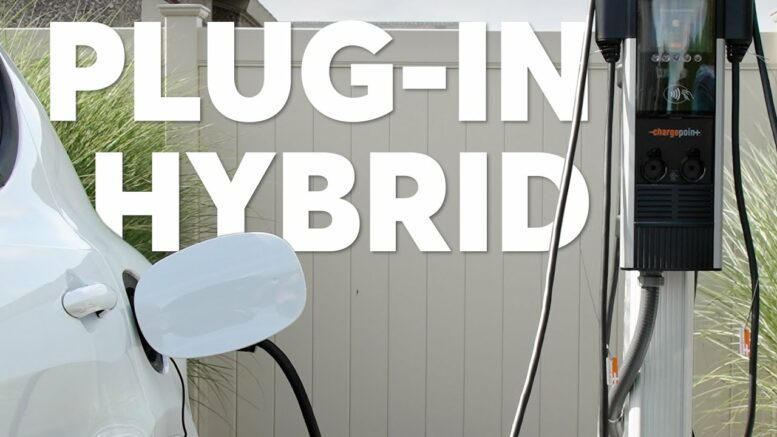We purchased over a dozen of plug-in hybrid electric vehicles (PHEV) for our auto test program at consumer reports, to study deeper and reveal many nuances of the most misunderstood vehicle. This week we share our initial impressions of some of our first interactions with plug-in hybrids and what we have discovered so far. Jake Fisher drafts a complex spreadsheet to help one of our audience members decide between a hybrid and a PHEV. We also answer if there is any correlation between the hybrid battery and the 12-volt battery in hybrid vehicles.
CR PHEV Cost Calculator:
SHOW NOTES
———————————–
Is a Plug-In Hybrid Vehicle Right for You?
Electric Cars 101: Answers to All Your EV Questions
Electric Cars and Plug-In Hybrids That Qualify for Federal Tax Credits
Car Safety Guide
Ratings and test results on every car CR purchases and tests:
Subscribe to Talking Cars on YouTube:
Have a question for our experts? Leave a comment on this episode, or reach out to us directly! Send us a text at TalkingCars@icloud.com to send a photo, video, or text directly to the Talking Cars team!
00:00 – Introduction
00:15 – Why (Plug-in Hybrid Electric Vehicle) PHEVs?
04:28 – What are plug-in hybrids?
07:28 – Who are PHEVs for?
12:10 – Plug-ins are a version of gas powered vehicles
13:39 – Our experience with 2023 Jeep Grand Cherokee 4xe (PHEV)
16:52 – Driving the 2023 Ford Escape PHEV
20:08 – 2023 Mazda CX90 PHEV
21:04 – PHEVs are not for everyone
26:08 – Question #1: Which plug-in hybrid should I buy?
31:22 – Question #2: Will a 12-volt trickle charger also keep the hybrid battery topped off?
Follow Us on Social:
TikTok:
Instagram:
Facebook:
Twitter:
Pinterest:






We started out with a 2019 chevy Volt, we loved that car but we were probably one of the few people who actually ran it on full electric mode for most of its life. We had a 220v charger installed and in the summer we could get over 60 miles of all electrric range.
Sadly we lostt that volt in an accident but we now own a Tesla M3 and a Chevy Bolt EUV. Plug in hybrids are great IF you get one with usable range and I would call usable range a minumum of 40 to 50 miles. You have to also consider that range goes down in winter when the batts are cold, so if your electric range is 40 miles you may only get 25 in winter.
You’re choice to go full ev makes so much since. If the 30 to 40 mile range was good for most of you’re neede that even a shorter range ev would be a good fit.
A few years ago we were looking at both PHEVs and BEVs. We probably would have purchased a Toyota RAV4 Prime had we been able to find one. After six months of waiting we had the opportunity to test drive an Ioniq 5. A week later we bought it and have been very happy with the decision. I can understand why a PHEV would make sense for some drivers. However, we found the EV ownership experience to be far easier and better than expected. I don’t see us ever buying another internal combustion engine.
BTW-EVs are less efficient at higher speeds than lower speeds but they’re far more efficient than gas vehicles at any speed.
Thanks for testing PHEVs. I’m extremely happy with my 2022 Prius Prime, which has an actual EV range of 32-36 miles.
Only save money when you go shopping?
no POINT in testing Hybrids anymore, the BEV is a SUPERIOR car.
Very good episode CR. You should also point out that not all PHEVs have the ability to control how and when the vehicle uses only Batteries or set when to use the ICE to recharge the Batteries (Pacifica PHEV/Hybrid for example). Some PHEVs, ownership is as simple as fill it up with Gas when it gets empty and plug it in every night.
I owned a gen1 volt from 2012 to 2017. I changed it due to seating comfort and related issues for long drives. After 70k miles and five years, I used gas only for about 5% of the miles. Visted dealer only two times for oil change. Total service costs under $200. Great car.
PHEVs are a great choice for most people.
Hybrids are a CRAPPY car w/ a Vibrator sized battery , for your Girlfriend.
Changing oil only 2 times in 5 years is not good for that ICE
Glad you did this video. I’m not likely to ever consider an EV, but toyed with the idea of a PHEV. After this video, I’d probably pass on a PHEV. I don’t drive enough to make it worthwhile. A hybrid, if it costs a lot more isn’t worth it for 6,000 miles a year that I drive. I lease & would buy/lease another hybrid for the environment. In Ohio it costs $100 more per year for renewing license plates on a hybrid, but they have to pay for roads somehow so that doesn’t bother me.
PHEVs are popular in Europe where more countries have CO2 based car tax. Phev gives you most of CO2 savings and cars cost many times less than gasoline car with same power.
This may be a short-term issue, but I think you also have to consider price and availability when selecting a PHEV. When I first started looking, around 18 months ago, the PHEV concept sounded great for my typical use, so I started shopping. What an eye opener! I learned a number of things. First of all, manufacturers don’t always offer PHEVs in all states. They seem to focus more on the “blue” states. The cars sellout fast, so good luck finding one, and if you do, be prepared to pay a big dealer add-on. When I first started looking, dealers were tacking $10k on top of the MSRP for the RAV4. Are you effing kidding me?! Sorry, just can’t do it. I decided to wait. I finally gave in last month and bought a 2024 Hyundai Tucson PHEV. I still paid MSRP, which is more than I wanted to pay, but I was able to buy it off the lot. Maybe price and availability are becoming more reasonable now.
So far, I’m very pleased with the Tucson.
My sister lives in surrey bc and she’s enjoying her hyundai tucson phev without being added to the list she went to the dealership and there was 1 available as it was supposed to have been ready for delivery and the buyer was transferred to Europe
If by blue you mean ZEV status states. Take that up with your representative. This isn’t a political thing. Most PHEVs are “compliance vehicles” meant to fit certain laws and standards so manufacturers can get incentives. If your state reps and lobbies don’t desire ZEV status that’s a decision you can raise your voice on.
A couple of observations: You are making this more complicated than it needs to be. Buy a PHEV if your normal use profile fits with what they are good at. Most people are not going to try to optimize every trip, and will leave the car in its automatic setting, where it will mix and max the power trains to provide the best result. In that setting, full power will always come on if you floor it. BEV’s are not difficult to charge, and only delay the start of charge when the owner sets it that way. If you have a level 2 charger, plug it in after the last trip of the day, unplug it when you start the first trip. You can set it for off-peak charging if you want. Road tripping a Tesla is not an anxiety producing event. It’s quite simple, the car tells you when to charge and routes you to the charger. No looking at a cell phone. Tesla public chargers are 99% reliable. You will usually go from10% to 80% in 20 minutes. There are many reasons to have a larger battery, than you need for day to day use. Get as much range as you can afford.
Phev is the best of both worlds many times. However quality of technology is not as even field as EVs.
Been driving my Prius Plug-in since 2013. Took it from SF area to Vancouver BC and back, Denver area and back, Oregon, Yosemite, etc.
50 MPG on the highway. At home, plug in at night to a wall outlet. Half my total miles are electric. Favorite car ever. These guys make it WAAAY too complicated.
Some PHEVs will not use the gas engine unless you select it or the battery is depleted (Chevy Volt, Ford Fusion are two that I’ve owned that work this way)
I’ve owned my RAV4 Prime XSE for 2 1/2 years. In that time I’ve accrued 50,000 miles; 60% electric. 40% gasoline. The gasoline engine, which most often is used on the highway, has averaged 38 mpg.
Acceleration is phenomenal. The AWD works well especially since I installed Michelin Cross Climate 2 tires a year ago.
If you pay attention and drive as this auto was designed the results will make you a believer. It has my wife who at first was very skeptical.
Same experience here. Toyota hit the sweet spot on electric range and hybrid gas efficiency and a super practical car for winter weather driving.
Why did you get rid of it ?
I went with the Jeep Wrangler 4xE
. I mainly purchased it because with the four cylinder turbo plus the electric motor in the transmission it gives you a lot more combined horsepower regardless of battery state than the non-plug-in hybrid version. I didn’t want to spend the extra money for their big 492 and the horrible gas mileage it gets. The bonus was since I have a level two charger in my garage for months on end for running errands around town I never use gasoline. And yes when I leave town and go on vacation it’s a hybrid with just a lot of extra power. Jeep replaced the alternator with a generator that powers the electric motor regardless of battery state so for me it’s a win.
Driving a PHEV isn’t as complicated as CR wants people to believe. We own a gen 2 Volt and a RAV4 Prime. Never any range anxiety and mostly EV driving. These vehicles are amazing. Chevy should have kept the Volt alive.
I think you got 2 of the best PHEV’s. Some don’t disable the gas engine ever and will kick on the engine if you ask for more than a certain amount of throttle. Also some have laughably short ranges – I know someone with an X3 PHEV and it gets 12 miles of EV range. Volt and RAV4 are some of the best PHEVs with long ranges and strong EV defaults.
Glad Toyota bumped the range on their Prius Prime, filling in the gap left by the Volt.
I agree with @skcbiol. Former Gen 1 Chevy Volt owner here. Even with the shorter EV range, I drove all electric 95% of the time. Amazing vehicle.
If you are trying to minimize your use of gas and you don’t want to hunt down chargers on long trips, it can be difficult to predict whether a PHEV or regular hybrid will be more efficient for your own likely driving. For me and my PHEV it has been the opposite of what they tell you — yes my EV range is down in the winter, but I do fewer long trips, so the PHEV beats the hybrid in the winter while the hybrid beats the PHEV in the summer. Overall, so far, it has been a toss up.
PHEVs are great for people who can charge at home and can find a PHEV that covers their daily commute in EV-only.
Also, PHEVs are not that complicated – the biggest complication is comparing them to each other because there are so many different ways to implement it and different EV ranges. But once you choose one, it is just a car that you usually plug in and can also run on gas.
Thank you for focusing an entire installment on PHEVs. Very informative, especially the (very granular) discussion of costs at the end. A topic that wasn’t covered, though, was the basic topic of plugging in. Given how poorly informed some are about EVs, PHEVs, HEVs, etc., it might haven been useful to discuss the importance of plugging in daily and that there is no need to upgrade the wiring in the garage to accommodate a PHEV. Because there is no consequence to forgetting to plug in—you’ll still be able to get to work—owners may fall out of the habit of routinely plugging in at night. Still, a very lively and useful discussion overall.
We don’t. I think in the past 2.5 years of ownership we’ve forgotten maybe twice. The biggest issue is to not plug in the vehicle after every short trip. Batteries have a limited number of recharge cycles – in the case of the Rav4 Prime that number is thought to be around 5,000 before the battery hits the 20% down mark. So if we are doing a series of short trips over successive days we’ll avoid plugging in. As a result, we have now put the battery through around 250 cycles. This means the batteries will likely last for our lifetime or the car’s lifetime (whichever ends first). Our goal is to drive the car, with the current battery, for 20 years.
Great video. I owned a Lexus RH300 which starts out in EV mode then switches on the gas engine when you exceed a certain speed (25-30 mph?). The initial acceleration was great but then it switched to a “regular” gas engine and ran mostly in that mode. I’m not sold on full electric vehicles since our infrastructure isn’t ready yet for mass EV transport-not to mention that the inconvenience of waiting for a charger or finding a “working” charger along the route are not acceptable to most drivers. Hybrids offer the best of both worlds and are the stepping stone technology in our pathway to a mass EV use consumer transportation methodology.
The major con for me of PHEVs is that you don’t get to skip the engine maintenance that really adds to the running cost. Take the Outlander PHEV, my folks have just bought one and so far they’ve used 10L to go 1400kms. Mitsubishi still expects them to come in and service the gasoline engine as if the engine was powering the entire thing. They will be required to change oil that has less than a half hour of run time on it if they want to maintain warranty.
Hello, great episode and very timely for me as my wife and I recently retired and trying to go down to one car. We want to make the transition to a more environmentally friendly vehicle. But that one car has to do everything – occasional long trips, many short trips, haul stuff, tow stuff, want AWD etc. because Toyota has been making hybrid for a very long time and have a proven track record (look at most taxi fleets, manny are the Prius hybrids), we are on a wait list for the RAV4 Prime. It is really a hybrid vehicle with a larger battery to give you 60km of pure EV range. When in hybrid mode about 6.2L per 100km (I will let you convert to US miles per gallon 😉).
However, in my heart, I would prefer to get a 100% pure EV, but cannot stomach the price premium nor have to rely on the charging infrastructure when on those “occasional “ long trips.
Your thoughts / other suggestions most welcome – I still have time to decide …. as you said, there is a long wait list for the Plug-in.
Thanks, keep the info coming 👍
Drove a Model Y for 3 months a couple of years ago, bought a used RAV4 Prime recently and absolutely love the Prime. in the first 2 weeks I drove about a mile in hybrid mode. It fits my typical driving perfectly and is so easy to deal with in terms of plugging in to a normal outlet etc.
Really interesting and entertaining. Great crew. I would have liked to learn more about charging a plug-in like how long it takes and level 1,2,3 what’s advised.
Also the two-powertrain conundrum. If I have a couple adults in the backseat isn’t that about the same weight as a gas powertrain? How much does having passengers really hurt your mileage? Worth a little test?
The biggest thing that went into my choice to go full electric was the moving parts. In a phev, you have the motor, battery, and a mechanical interface with the gasoline engine. In the gasoline engine alone there are hundreds of components plus the transmission which has to shift gear to gear. In an ev you just have one gear, a motor and a battery.
Great episode. I run a VW Golf GTE PHEV in Europe and can back up all the observations made. PHEVs really work well if you have a commute that fits comfortably within the battery range and can charge at home. Things get even better if you can use cheaper off-peak electricity pricing and/or your employer offers some subsidized charging at work. Of course, any charging available at work gives you the option of more range as a result. It is a shame more PHEVs are not on the market in the US, and that the price premium is often so high. I bought my Golf used, and paid a very small premium over the equivalent ICE model. The benefit of the GTE is that it has about 200HP with both the ICE and EV elements combined, which mean it is almost as fast as the GTI model
Many of the first PHEVs in Europe were a sort of “compliance special” spec – enough EV range to get around restrictive rules on congestion and emissions but not really that practical to use as a mostly-EV. That is changing and the price is coming down. Toyota had bet big on hybrids (not so sure about PHEVs) so may be placed well as the US buyer goes looking for a new car, but would rather not commit 100% to an EV